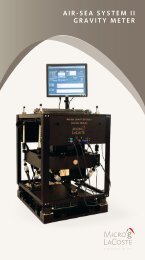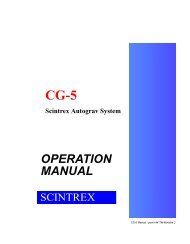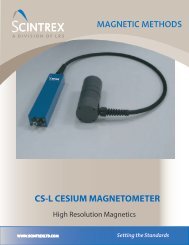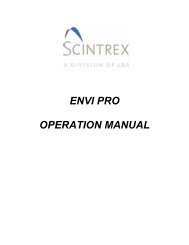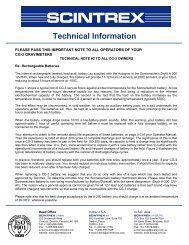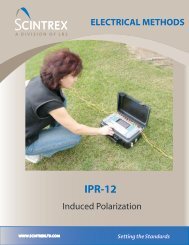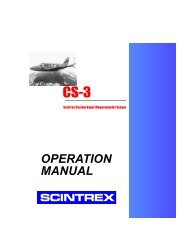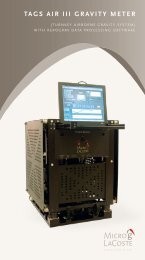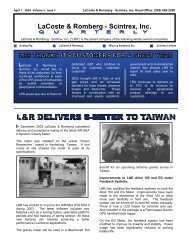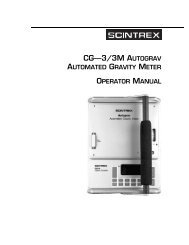CS-L Cesium Vapor Magnetometer Sensor OPERATION ... - Scintrex
CS-L Cesium Vapor Magnetometer Sensor OPERATION ... - Scintrex
CS-L Cesium Vapor Magnetometer Sensor OPERATION ... - Scintrex
You also want an ePaper? Increase the reach of your titles
YUMPU automatically turns print PDFs into web optimized ePapers that Google loves.
Operating<br />
3—4<br />
output restricts the maximum cable length to a maximum of approximately 8<br />
meters. An external line driver is required if the signal is to be transmitted<br />
over a longer distance.<br />
• sinewave Larmor signal is transformer coupled inside the sensor electronics<br />
box on to the D.C. power supply line. This is done in a similar way as in the<br />
older models of Varian and <strong>Scintrex</strong> cesium vapor magnetometers. The only<br />
difference that the output amplitude of the <strong>CS</strong>-L is electronically stabilized to<br />
be independent of the sensor orientation or slightly dependent of the Larmor<br />
frequency over the range of 50-350kHz. This additional feature will prevent<br />
the sensitivity of the magnetometer to deteriorate more than necessary in<br />
presence of the power supply noise. The power supply noise affects more the<br />
signal with the lower amplitude.<br />
Couplers, Processors and Power Supplies<br />
In older magnetometers the output amplitude was varying as much as 10:1.<br />
The <strong>CS</strong>-L magnetometer could easily replace, as far as the power and signal<br />
conditioning is concerned, the older models without any changes to the<br />
existing equipment such as sensor couplers, magnetometer processors, power<br />
supplies.<br />
The only incompatibility is in the control of the operating hemisphere, as it<br />
will be explained in the next section. The Larmor signal coupled on the<br />
coaxial power cable could be transmitted to the processor (decoupler) over<br />
a distance of up 100 meters before it is decoupled by a transformer.<br />
Setting the Operating Hemisphere<br />
It has been briefly explained why the operation of the <strong>CS</strong>-L is divided in two<br />
operating hemispheres in Chapter 2, “Getting Started with the <strong>CS</strong>-L”.<br />
Chapter 4, “Orienting Your <strong>CS</strong>-L” defines the operating hemispheres in more detail,<br />
and provides instructions on how to orient the sensor head.<br />
Here, we explain how the operator can control the setting of the operating<br />
hemisphere. The Hemisphere Control switch is used to select the mode of<br />
control. FOUR modes of control of the operating hemisphere setting are<br />
available:<br />
Manual Control<br />
Two positions of the Hemisphere Control switch are used for the manual control:<br />
• in position "N" the <strong>CS</strong>-L is set manually to operate in the northern operating<br />
hemisphere.<br />
• in position "S" the <strong>CS</strong>-L is set manually to operate in the southern operating<br />
hemisphere.<br />
Electronic Control "R"<br />
In the position "R" of the Hemisphere switch, the setting of the operating<br />
hemisphere is actuated by the TTL/CMOS compatible control voltage level at the pin<br />
D of the four pin I/O connector: open circuited or high level voltage for<br />
setting the operation in southern hemisphere, low level voltage or short<br />
connection to the pin A for operation in northern operating hemisphere.<br />
P/N 763701 Rev. 1



